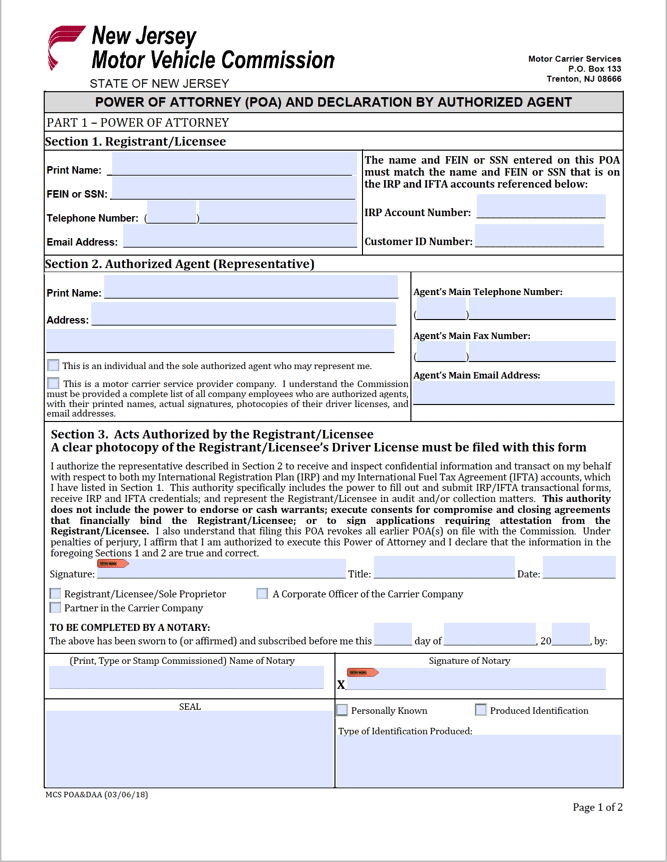New Jersey Motor Vehicle Power of Attorney Form
A New Jersey motor vehicle power of attorney is a form completed by a registrant or licensee to give an authorized agent (or representative) the ability to act on their behalf while carrying out vehicle-related tasks. Similar to a limited power of attorney, the form gives the agent permission to complete one-time, specific duties. The registrant can ask the representative to register or title the vehicle, request a duplicate title, or sign documents for them. If the licensee wants to assign additional tasks or provide instructions, they can attach a supplemental form to the motor vehicle power of attorney.
The registrant can select an individual or a motor carrier service provider company as the agent. When completing the form, they must check the box that best represents the agent’s role. Additionally, they must include the name, address, telephone and fax numbers, and email address of the agent. The licensee must print their name and enter their social security number (SSN) (or federal employer identification number (FEIN)), telephone number, and email address. Upon signing, they need to check the box corresponding with their role. They can choose from the following options: 1) registrant/licensee/sole proprietor, 2) corporate officer of the carrier company, or 3) partner in the carrier company.
By signing, the licensee gives the representative permission to sign documents, request information, apply for a registration and title, and handle other matters regarding the vehicle. The agent must have a physical copy of the motor vehicle power of attorney, along with a photocopy of the registrant’s driver’s license, when acting in their place. Unlike other states, New Jersey requires the agent to sign the form. The representative must read the section on page two (2) of the document, then print, sign, and date it.
Signing requirements: Licensee, Agent, and Notary Public must sign.
How to Write
Download: PDF
Step 1 – Licensee Information
The licensee (the one granting authority) may be an individual or business. Complete this top section by providing the licensee’s name, Federal Employer Identification Number (FEIN) or Social Security Number (SSN), telephone number, email address, and IRP Account Number, and Customer ID Number (if applicable).

Step 2 – Agent Information
The agent, or representative, is the attorney-in-fact who will act on the licensee’s behalf. Fill out this section by writing the agent’s name, address, phone number, fax number, and email address. Click or manually check the box that is most appropriate.

Step 3 – Sign in Front of Notary Public
In front of a Notary Public, the vehicle owner must endorse and date the form. Place a checkmark next to the applicable box to indicate whose signature is above.

Step 4 – Ensure Notary Public Completes Form
After witnessing the vehicle owner sign, an official Notary Public must fill out the bottom section of the first page. He or she must include their name, seal, date, and signature. Before signing, the vehicle owner must show the Notary Public a valid form of identification. The Notary Public is required to state the type of identification given. If applicable, he or she must include the number associated with the identification, such as with a driver’s license.

Step 5 – Name the Registrant/Licensee
The state requires the agent (attorney-in-fact) to declare that he/she is authorized to represent the registrant or licensee. On the top of the second page, enter the name of the registrant or licensee and their Federal Employer Identification Number (FEIN) OR Social Security Number (SSN).
![]()
Step 6 – Representative Declaration
After reading through the declaration, the agent must bring this form before a Notary Public and provide his/her name, signature, and current date. The Notary will then notarize the form.

